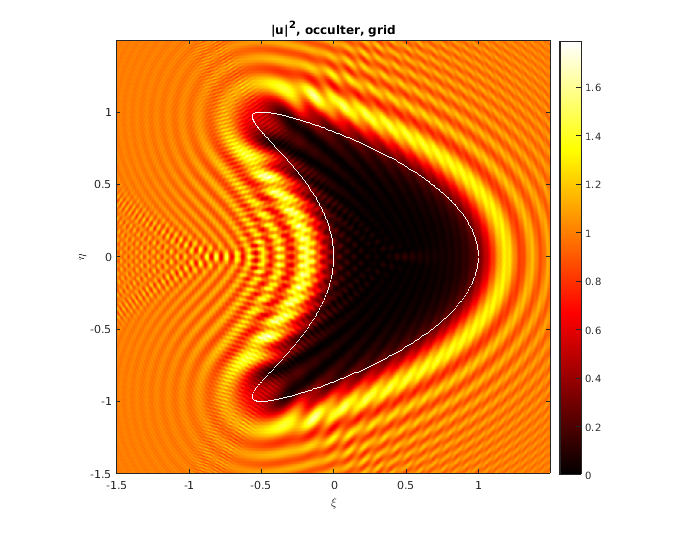FRESNel Areal Quadrature: Fast nonuniform Fourier method for computation of scalar Fresnel diffraction from binary (hard-edged) apertures and occulters, in MATLAB/Octave. The simulation of the optics of starshades for exoplanet imaging is one application.
Here is an example. The intensity due to diffraction from a smooth kite-shaped occulter at Fresnel number around 20 is evaluated at one million targets, to 9-digit accuracy, in 0.05 s on a laptop. All fringes are correct and not numerical or sampling artifacts. The occulter boundary is shown in white:
This package computes 2D Fresnel diffraction integrals of the form:
in the case of a planar aperture Ω, or one minus this in the case of an occulter. Here z is the propagation distance and λ the wavelength. The package does this rapidly at a large numbers of target points (ξ,η), either on a grid, or arbitrary, given an accurate areal quadrature for the domain Ω. See our preprint listed at the bottom.
- MATLAB (has been tested back to R2016b), or Octave (version >= 4.4)
- FINUFFT preferably >= v2.0.0
Install FINUFFT and compile its MATLAB interface.
Add finufft/matlab to your MATLAB path.
In MATLAB run startup then fresnaq_grid to run tests which should
produce very small error outputs and take <0.1 sec to run.
The main library functions we provide are:
fresnaq_grid.m: compute diffracted amplitude on regular square centered gridfresnaq_pts.m: compute diffracted amplitude at arbitrary target points
Both routines are documented and can be tested by calling them with no arguments. Run testall to go through all library component tests.
The user should run demo_*.m to produce pretty pictures and see
how to call the library.
The above example is produced by setting verb=2 in demo_paramcurve.m.
Since areal quadratures are key, there are various
quadrature helper routines in util used in the tests and demos.
One starshade description file is shipped in occulters, along with
some preliminary shadow results as PNGs.
A movie sweeping wavelength is here, which took only 30 s to compute.
A notch-like perturbation to an ideal starshade is handled and demo'ed by
utils/starshadenotch.m.
The directory sister_mods contains a self-contained subset of the SISTER
codes, essentially sister_basis.m and everything it requires, severely
hacked to use FRESNAQ instead of BDWF. The speed-up achieved is around
10000x, not including file I/O, and one PSF pupil grid is validated to
6-digit accuracy.
See bdrymeths directory for BDWF and the new reference non-singular line integral (NSLI) method for Fresnel scalar diffraction.
BDWF was needed as the current state of the art; we ship a documented version
of Cady's code from SISTER v1.1.
This is used for speed comparisons and validation.
NSLI is a more robust and mathematically simpler formulation
in the on-axis, constant-z case,
which also can achieve high-order accuracy (unlike BDWF which is 2nd-order),
when fed an appropriate boundary quadrature. NSLI contains only around eight lines of code (but much more in the form of documentation and testing).
Note: The term "boundary integral" refers to a line integral over the aperture/occulter boundary, and should not be confused with 3D integral-equation based wave scattering methods (which would go beyond the Fresnel approximation, and are significantly more time consuming and harder to code).
Please see our paper here, and cite this if you use this software:
- Efficient high-order accurate Fresnel diffraction via areal quadrature and the nonuniform FFT, Alex H. Barnett, J. Astron. Telesc. Instrum. Syst. 7(2), 021211 (2021). arxiv, published
The codes used to generate all figures and tables in this paper is in the paper/fig_gen_codes directory.


